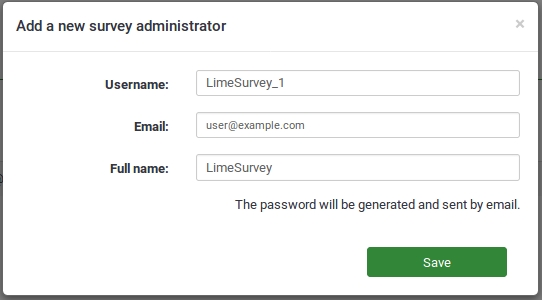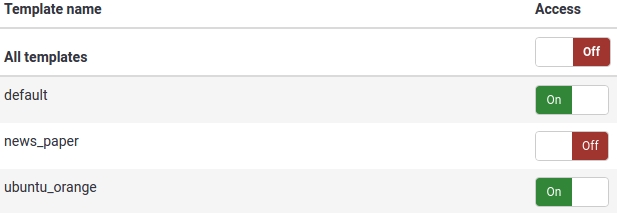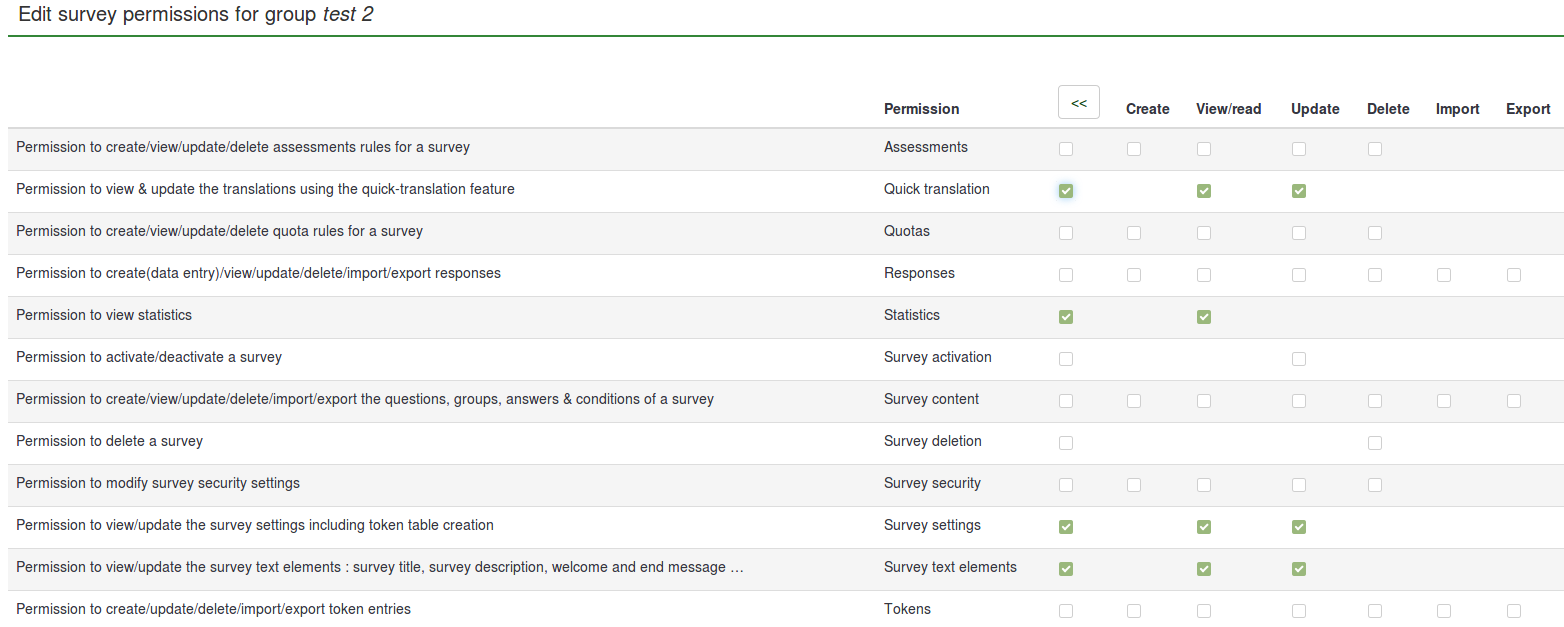Manejo de Usuarios
From LimeSurvey Manual
General
Al hacer click en el ícono ![]() se abre la ventana para el manejo de usuarios. Dependiendo de los permisos que tenga asignados, podrá cambiar su contraseña o manipular otras cuentas de usuarios cambiando sus privilegios.
se abre la ventana para el manejo de usuarios. Dependiendo de los permisos que tenga asignados, podrá cambiar su contraseña o manipular otras cuentas de usuarios cambiando sus privilegios.
En este contexto, el término usuario se refiere a un alguien que puede hacer login a la interface de administración de encuestas
Si quiere darle a un usuario acceso limitado a una encuesta,
- primero debe crear el usuario;
- luego, elegir la encuesta en el panel de administración;
- elegir "Survey security settings" (Configuración de seguridad para la encuesta),
- agregar el usuario
- y configure los permisos de acceso de la encuesta (En inglés) para el usuario.
La herramienta de administración de usuarios le permite agregar usuarios administrativos adicionales a LimeSurvey. Nos referimos a ellos como "usuarios". No los confunda con participantes de la encuesta (encuestados).
Agregar un usuario
Para crear un nuevo usuario, abra el cuadro de diálogo de administración de usuarios haciendo clic en Configuración (ubicado en la barra de herramientas principal de LimeSurvey) -> Administración de usuarios.

Luego, haga clic en Agregar usuario ubicado en el área superior derecha de la tabla Control de usuario. Se mostrará una ventana pidiéndole que:
- Ingrese el nombre de usuario deseado en el campo Nombre de usuario.
- Ingrese la dirección de correo electrónico en el campo Correo electrónico. Tenga en cuenta que:
- LimeSurvey envía un correo electrónico de confirmación a la dirección ingresada en el campo 'Correo electrónico. Esta dirección de correo electrónico se utilizará como dirección de correo electrónico de contacto estándar para las encuestas creadas por el usuario respectivo.
- Si no desea que el usuario reciba el correo electrónico de confirmación con un enlace a la aplicación LimeSurvey, nombre de usuario y contraseña, Puede utilizar su propia dirección de correo electrónico para enviarle el correo electrónico de confirmación. Después de eso, puede cambiar la dirección de correo electrónico a la dirección del usuario.
- Ingrese el nombre completo del usuario en el campo Nombre completo. Tenga en cuenta que el nombre completo ingresado aquí se utilizará como el nombre de la persona de contacto estándar para las encuestas creadas por el usuario respectivo.
- Haga clic en Guardar para crear el nuevo usuario.

Ya ha creado su primer usuario. Para obtener más información sobre configurar permisos de usuario, siga leyendo.

A continuación puede ver cuatro opciones en la columna Acción que le permiten:

- editar los aspectos generales de un usuario - haciendo clic en el símbolo del bolígrafo.
- eliminar el usuario de la base de datos de administradores de encuestas - haciendo clic en el botón de la papelera.
- establecer permisos globales para un usuario - haciendo clic en el símbolo de candado .
- establecer permisos de tema para un usuario, haciendo clic en el símbolo del lápiz y el candado.
Editar usuario
Haga clic en el icono del lápiz para editar la información del usuario.
Puede ingresar una nueva dirección de correo electrónico, nombre y cambiar su contraseña. Haga clic en Guardar para confirmar los cambios.
Eliminar usuario
Para eliminar una cuenta de usuario, haga clic en el icono de papelera correspondiente (ubicado en la misma línea que la cuenta de usuario que desea eliminar) y haga clic en Aceptar.
Establecer permisos globales para un usuario
Para establecer permisos globales para un usuario, haga clic en el símbolo de candado.

Se emplea el sistema CRUD (crear, leer, actualizar y eliminar) (como está en la configuración de permisos de encuesta). Para obtener más opciones de permisos de usuario, recomendamos extender la matriz usando la punta de flecha doble derecha, que se encuentra en la esquina superior derecha. Si marca la primera casilla, todos los permisos CRUD en esa fila se marcan automáticamente.

Para cada usuario, independientemente de la encuesta, puede tener estos permisos:
- Permisos de superadmin
- Crear encuestas
- Configurador
- Crear usuarios
- Borrar usuarios
- Administrar templates o plantillas
- Administrar label-sets/labels
- Participant panel: For more details, continue reading about the central participant database here.
- Label sets: Permission to create, view, update, delete, export, and import label sets. The label sets do not have specific permissions (unlike themes).
- Settings & Plugins: With this permission a user can check data integrity, save the SQL database to an .sql file, manage global settings, view the PHP info in the global settings, and manage all plugins.
- Survey groups (New in 4.4.0 ): Give access to all surveys' group. To allow user to manage their own surveys' group, give the user the 'create' permission. A creator of a surveys' group are (by default) the owner of this surveys' group.
- Surveys: Gives access to all surveys. To allow a user to only create and manage their own survey, give the user the 'create' permission. A creator of a survey is the owner of the survey and will always be able to manage it. Remember that each survey can grant different permissions .
- Themes: Allows the user to use all the available design themes and edit all non-standard themes. A person with this permission should have sufficient knowledge in terms of HTML, Javascript, and CSS. If a user is not familiar with these things and is supposed to use a specific design themes, it would be better to only give them 'read' permission. Each theme can have specific permissions.
- User groups: Allows a user to create/view/update/delete user groups.
- Users: A user can create, modify, and delete their own administration users with this permission. The newly created users cannot have higher permissions than the parent user. You will also not be able to edit users owned by other administration users. If this has to be done, then a Superadministrator permission must be granted.
- Superadministrator: Can only be added by other Superadministrator with this setting as update and grants full permission to the whole LimeSurvey application, including installing plugins and using any kind of content (including JavaScript) in survey content. (see also global security settings)
- Use internal database authentication: Allows users to access LimeSurvey's panel via the authentication page (e.g. http://domain/admin/authentication/sa/login). If it is unchecked and the respective user tries to connect to LimeSuvey's panel, they will get the following error: 'Internal database authentication method is not allowed for this user'.
Set theme permissions for a user
With theme permissions, you can decide which design themes a user can select when creating or editing a survey.
If you have specific design themes for a group of users or customers, you can restrict their access to other themes to ensure that they use only themes created for them.
To set or edit the themes permissions for a user, click the pen-and-lock symbol for design themes.

Select the design themes to which the respective user or user groups should have access. After you finished your selection or deselection, do not forget to click Save: ![]() .
.
To better understand this function, view the examples provided below.
Use one-time passwords
A user can call the LimeSurvey login at /limesurvey/admin and enter a username and a one-time password (which was previously written into the users table - column one_time_pw - by an external application).
To enable this login method, the line 'use_one_time_passwords' => true; has to be added to config.php (it is 'false' by default) .
The URL has to contain the following variables:
- user: The username normally used to login into LimeSurvey. This username has to exist in the 'users' table of the database.
- onepass: The plain text password which is then compared to the password in the 'users' table
A valid URL to login using a one-time password will look like this:
Things to watch out for:
- To enable this login method, the line
'use_one_time_passwords' => truehas to be added in config.php (it is 'false' by default). - The passed username has to exist in the LimeSurvey users table.
- The one-time password (which can be set via an external application) has to be stored as MD5 hash in the column one_time_pw of table users.
- The passed plain text password will be hashed using the sha256 function and will then compared to the stored hash in column one_time_pw of table users. Both passwords have to match.
- After the first login with the one-time password, it gets deleted from the database. The user won't be able to log in with that respective password a second time.
Permiso de configurador
Este permiso determina si el usuario puede ejecutar las siguientes acciones:
- Chequear la integridad de los datos
- Hacer backups o resguardos de la base de datos
- Acceder a la información de phpinfo en la pantalla de overview summary
To change the survey permissions, click the Settings tab. Then, click Survey permissions and choose to whom would you like to offer permissions. The permissions can be offered either separately to specific users or to a user group.


Grant survey permissions to a user
In the next step, select the user that will receive survey permissions and click Add user.

After you click Set survey permissions, the user's survey permissions matrix will be shown.

You can set in this matrix the user's survey permissions. Checking a box grants survey permissions to the respective user. If you click a checkbox from the first column, all the permissions of the corresponding line will be selected/removed.
Click the double-right arrowhead to access the extended version of the matrix to choose specifically the actions that can be performed by a user. After you finished editing the survey permissions, click Save, which is located in the upper right corner of the screen.
Some examples are provided below in order to help you get a better understanding of Limesurvey's survey permissions system.
Grant survey permissions to a user group
Click add a user group and select the user group to which you would like to add the permission permissions.
In the next step, select the permissions that you will allocate to the members of that user group. Do not forget to click the double right arrowhead to get an extended view of the permissions matrix.

After you have finished editing the survey permissions, click Save, which is located in the upper right part of the screen.
Some examples are provided below to help you get a better understanding of the Limesurvey's survey permissions system.
Permiso para crear/borrar usuarios
Se le puede dar a un usuario el permiso para crear otros usuarios. En este caso, podran darle a los nuevos usuarios, como mucho, los permisos que ellos mismos tienen, pero no más.
En el caso de que un usuario requiera mayores permisos que su 'padre', el primer superadmin deberá 'adoptar' a este usuario haciendo click en 'Take Ownership', en la linea que describe al usuario.
Sólo entonces el administrador podrá darle al usuario los permisos requeridos.
Por otro lado, un usuario puede tener permisos para borrar los usuarios que ha creado.
Add new LimeSurvey adminisrator
- Log in as admin.
- Create a new user account.
- Grant that user the Superadministrator permission.
- Not necessary : Setting the theme permissions (Superadministrator has all permissions for all themes).
- Not necessary : Setting the survey permissions (Superadministrator has all permissions for all surveys).
A new user wants to create their own surveys
- Log in as admin (or as a user that has the Superadministrator permission).
- Create a new user account.
- Set global permissions for that user to Create survey.
- Optional : Set theme permissions - select which theme(s) should be used by the user/user group.
Permisos de superadmin
Un usuario con SuperAdmin tiene el permiso de administrar todos los objetos del sistema (encuestas, preguntas, plantillas, etiquetas, usuarios).
Sin embargo, sólo el primer superadmin (el configurado durante la instalación), puede dar este privilegio a otros usuarios.
Permisos sobre templates o plantillas
El botón 'Set Template Rights' permite especificar qué plantilla puede usar un usuario en sus encuestas. La plantilla 'default' siempre está accesible para todos los usuarios.
NOTA: Aquí estamos hablando del permiso para usar la plantilla, y NO para modificarla.
Permisos sobre Labelset
Este permiso habilita a los usuarios a editar los labelsets globales a todas las encuestas.

Granting permission for help with translation of a survey
- Log in as admin (or as a user that has the Superadministrator permission).
- Create n user accounts (where n is the number of translators).
- Create a user group called Translators and add the n accounts to this group.
- Go to the Survey permissions and click on Add a user group.
- If they only do translations, then offer them the Quick translation permission.